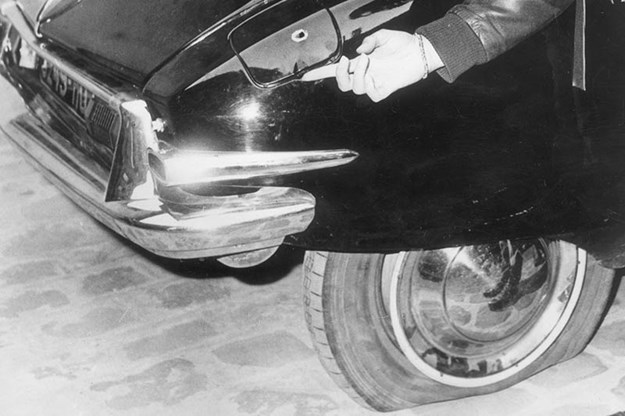Fixing a flat tyre the French way - Faine 446



|
From finding a flat to fixing it, no one does it like the French
I have not had a puncture for years. And then it happened. Mid afternoon I noticed the rear passengers side tyre was looking a little saggy as I parked the Citroen DS23. Since I had to cross town, only about 10ks, I decided that all was fine and I would blow in some air as soon as I got home and tucked her away in her cosy garage.
Nope. Not to be. Two minutes from home I stopped to get some cash from an ATM and as I walked back to the car I saw the dreaded scene. The tyre was totally deflated.
Now you are no doubt shouting at the magazine like a crazy person - what sort of idiot would be driving a car with a flat tyre and not notice something was wrong? Well, an idiot in a hydraulic suspension Citroen, that is who. A system that compensates for varied weight and height and disguises a flat tyre so you have little idea anything is amiss.

Cue my favourite Citroen DS story of all time. Settle into your armchairs for a brief history lesson. General Charles De Gaulle was the hero of the French resistance to the Nazis when they brutally occupied France in WW2. After the war he became President and united a fractured and ruined nation. The French revered him - a bit like we would not hear a bad word about…. about… um… er… well, like Vladimir Putin is adored by 98% of Russians [according to Vladimir Putin].
In the 1950’s France was locked into a brutal and bloody struggle with independence activists in Algeria. For a hundred years, Algeria had been a French colony. But in post-war Europe, struggling to emerge from the rubble, De Gaulle bowed to an Algerian terrorist campaign, backflipped and agreed to independence. Outraged French imperialists, many of them from the military, tried to assassinate De Gaulle for what they felt was betrayal of France. Only his Citroen DS saved him.
On a grey morning in 1962 De Gaulle embarks on a routine trip to the airport. In an ambush over 140 machine gun bullets are fired at his car, puncturing three of the four tyres and lacing the bodywork. The President ducks down to the floor - no small feat as he was about eleven foot tall - and his chauffeur [is there a French word for chauffeur?] races away. The suspension hydraulics keep the DS on an even keel DESPITE THREE TYRES BEING SHOT OUT. I say that again - three dead tyres but no dead President. The Citroen maintains equilibrium and saves his life.
So there I am outside the ATM staring at my 1975 DS23 thinking "Well if De Gaulle’s chauffeur could escape assassins with only one good tyre how about I drive home slowly with three"? I contemplate the party trick of driving home on three wheels but opt for the more conventional response of changing a tyre.

No need for a jack with hydraulic suspension
I am no newcomer to this procedure but on the side of the road, in the dark, in good clothes it is very different to doing it in overalls in a well equipped shed. First step - with the engine idling lift the suspension height lever to its highest and open the bonnet. While the hydraulic pump lifts the entire car to almost 4x4 height, take out the spare tyre, bouncing it to check if it has more air in it than the punctured tyre.
Next step is to remove the rear quarter panel. In conventional cars this requires a four year apprenticeship and a panel beater’s workshop. With a DS Citroen, it requires a 19mm spanner and the removal of one bolt. The entire rear panel lifts off its channel. Next, use the supplied tool to prise the chrome hubcap off the wheel and then use the same tool to prop the triangular chock under the centre sill. Loosen the wheel nuts and then slide the height selector to "low" and the car sinks, lifting the flat tyre off the ground ready to be replaced.
Problem - the special wheel brace that lives in a dedicated spot in the nose of the engine compartment is not there. I curse and search for any other tools and find a roll of spanners that I have thoughtfully left in the car in case of misadventure. I have to use a standard open end spanner to undo the wheel nuts – ugh – and manage to do so without aggravating any of the bulging discs in my fragile spine. Wheel nuts off, the spare is whacked onto the studs, nuts back on, rear quarter panel replaced and then all I need do is put the car back to its highest, remove the chock, height lever back to normal and close the bonnet. Drive home safely. De Gaulle would approve.
Unique Cars magazine Value Guides
Sell your car for free right here
Get your monthly fix of news, reviews and stories on the greatest cars and minds in the automotive world.
Subscribe

.jpg)













